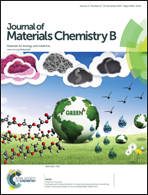Fast setting and anti-washout injectable calcium–magnesium phosphate cement for minimally invasive treatment of bone defects
Abstract
The development of injectable calcium phosphate cements (ICPC) represents a promising approach for minimally invasive surgical techniques. However, the undesirable anti-washout property and slow setting time of ICPC greatly hinder its clinical application. Xanthan gum (XG) has strong hydrophilic, shape retention and rheological properties. In this study, a fast setting and anti-washout injectable calcium–magnesium phosphate cement (fa-ICMPC) was developed by introducing XG, as an anti-washout agent, and magnesium phosphate cement (MPC) into calcium phosphate cement (CPC). The bone-regenerative capacity and the bioresorption of the fa-ICMPC were also investigated by injecting it directly into a rabbit thigh bone defect. The result showed that XG imparted anti-washout properties to the fa-ICMPC and enhanced the injectability of the fa-ICMPC. With the protection of thick viscous films formed by XG, the setting of the fa-ICMPC was not disturbed but accelerated due to the synergistic effect of MPC. The result demonstrated that fa-ICMPC was not crumbled and could fill the defects tightly. The newly-formed bone tissue grew into fa-ICMPC along with the degradation of the materials. In short, the fa-ICMPC exhibited potent anti-washout properties, fast setting, improved injectability, good biodegradability and osteoconductivity, and has the potential to repair bone defects by minimal invasive treatment.


 Please wait while we load your content...
Please wait while we load your content...